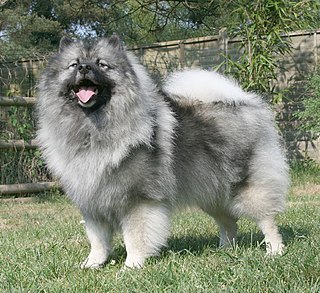
The Keeshond is a medium-sized dog with a plush, two-layer coat of silver and black fur with a ruff and a curled tail. Their closest relatives are the German spitzes such as the Großspitz, Mittelspitz, Kleinspitz, Zwergspitz (Dwarf-Spitz) or Pomeranian.

The Bichon Frisé or Bichon à Poil Frisé is a Franco-Belgian breed of small toy dog of bichon type. It was recognised by the Société Centrale Canine in 1933 and by the Fédération Cynologique Internationale in 1959.
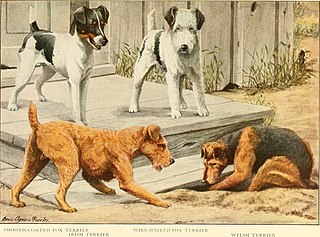
Terrier is a type of dog originally bred to hunt vermin. A terrier is a dog of any one of many breeds or landraces of the terrier type, which are typically small, wiry, game, and fearless. There are five different groups of terrier, with each group having different shapes and sizes.

The Scottish Terrier, popularly called the Scottie, is a breed of dog. Initially one of the highland breeds of terrier that were grouped under the name of Skye Terrier, it is one of five breeds of terrier that originated in Scotland, the other four being the modern Skye, Cairn, Dandie Dinmont, and West Highland White terriers. They are an independent and rugged breed with a wiry outer coat and a soft dense undercoat. The first Earl of Dumbarton nicknamed the breed "the diehard". According to legend, the Earl of Dumbarton gave this nickname because of the Scottish Terriers' bravery, and Scotties were also the inspiration for the name of his regiment, The Royal Scots, Dumbarton's Diehard. Scottish Terriers were originally bred to hunt vermin on farms.

The Affenpinscher is a German breed of small toy dog of Pinscher type. Originally developed as a mouser, the Affenpinscher is now commonly found as a companion worldwide.
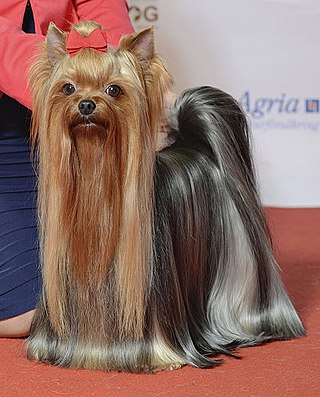
The Yorkshire Terrier, also known as a Yorkie, is a British breed of toy dog of terrier type. It is among the smallest of the terriers and indeed of all dog breeds, with a weight of no more than 3.2 kg (7 lb). It originated in the nineteenth century in the English county of Yorkshire, after which it is named. The coat is tan on the head and dark steel-grey on the body; no other colour is accepted by either The Kennel Club or the Fédération Cynologique Internationale.

The Miniature Schnauzer is a breed of small dog of the Schnauzer type that originated in Germany in the mid-to-late 19th century. Miniature Schnauzers may have been developed from the smallest specimens of the Standard Schnauzer, or crosses between the standard and one or more smaller breeds such as the Affenpinscher, Miniature Pinscher, and Poodles, as farmers bred a small dog that was an efficient ratting dog. They are described as "spunky" but aloof dogs, with good guarding tendencies without some guard dogs' predisposition to bite. Miniature Schnauzers are recognized in four colors internationally: solid black, black and silver, salt and pepper, and white.

The West Highland White Terrier is a breed of dog from Scotland with a distinctive white harsh coat and somewhat soft white undercoat. It is a medium-sized terrier, though with longer legs than other Scottish terriers. It has a white double coat of fur which fills out the dog's face, giving it a rounded appearance.

The Smooth Collie is a breed of dog developed originally for herding. It is a short-coated version of the Rough Collie of Lassie fame. Some breed organisations consider the smooth-coat and rough-coat dogs to be variations of the same breed.

The soft-coated Wheaten Terrier is a pure-breed terrier originating from Ireland. Wheatens typically have one of two coat types: Irish or Heavy (American). The Irish coat is generally silkier and wavier than the Heavy, or American coat, which is thicker and fuller. The Soft Coated Wheaten Terrier is named for its silky, wheat-colored coat. Wheatens are generally friendly and playful, and tend to get along well with children and other dogs.

The Border Terrier is a British breed of small, rough-coated terrier. It originates from the area of the Anglo-Scottish border, and shares ancestry with the Dandie Dinmont Terrier and the Bedlington Terrier from the same area. The dogs were traditionally used in fox-hunting, and worked with the Border Hunt in Northumberland.

The Kerry Blue Terrier is a breed of dog. Originally bred to control vermin including rats, rabbits, badgers, ferrets, foxes, otters, hares, deer, and even wolves, over time the Kerry became a general working dog used for a variety of jobs including herding cattle and sheep. Despite a Kerry Blue winning Crufts in 2000, it remains an "unfashionable" breed, and is distinctly uncommon; however, it is not as threatened as some of the other terrier breeds such as the Skye Terrier, Sealyham Terrier, and Dandie Dinmont Terrier.

The Lhasa Apso is a non-sporting dog breed originating in Tibet. Traditionally the breed has been used as an interior watchdog.

The Black Russian Terrier, also known as the Chornyi Terrier, is a breed of dog from the USSR. It was originally bred in the Red Star Kennel during the late 1940s and the early 1950s for use as a military/working dog. The Black Russian Terrier is a breed recognized by the FCI, AKC, CKC, KC, ANKC, NZKC and other cynological organizations. The contemporary Black Russian Terrier is a working dog, guarding dog, sporting and companion dog.
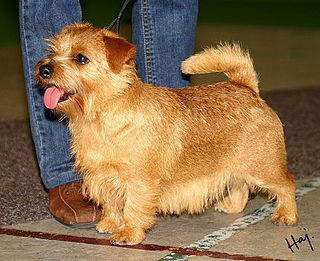
The Norfolk Terrier is a British breed of dog. Prior to gaining recognition as an independent breed in 1964, it was a variety of the Norwich Terrier, distinguished from the "prick eared" Norwich by its "drop ears". Together, the Norfolk and Norwich Terriers are the smallest of the working terriers.
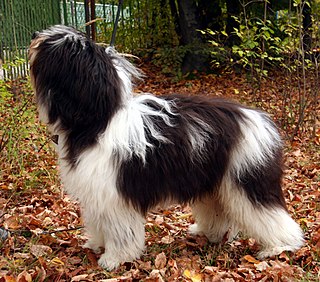
The Polish Lowland Sheepdog, is a medium-sized, shaggy-coated, sheep dog breed native to Poland.

The Kromfohrländer is a modern German breed of companion dog. It originated in Germany in the years after the end of the Second World War. There are two coat types, a smooth-haired and a rough-haired.

The Skye Terrier is a Scottish dog breed that is a long, low, hardy terrier and "one of the most endangered native dog breeds in the United Kingdom" according to the Kennel Club.

The Barak or Bosnian Broken-haired Hound, is a hunting dog breed developed in Bosnia. The breed is a scenthound, originally used to hunt large game. Other names include Bosnian Rough-haired Hound and Bosnian Rough-coated Hound. These names refer to the texture of the shaggy coat, usually called broken-haired or hard in English dog fancier jargon.

The Continental Bulldog, or Conti for short, is a newer dog breed created in Switzerland. It is officially recognized by the FCI since 2022.
























